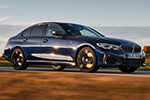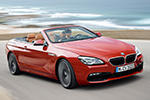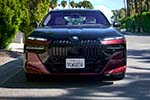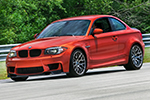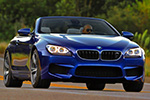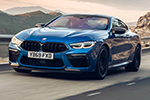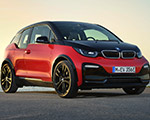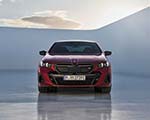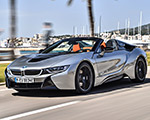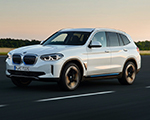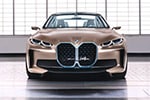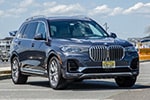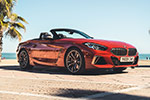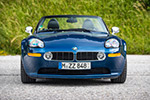The battle for the electric luxury SUV crown just got serious. BMW and Mercedes-Benz have unveiled their most important EVs yet—the all-new BMW iX3 and Mercedes-Benz GLC EV. Both promise big range, lightning-fast charging, and the kind of performance German automakers are known for. But with Tesla and Chinese brands raising the bar, which of these two heavyweights really comes out on top? Here’s how the specs stack up.
| Spec | BMW iX3 50 xDrive | Mercedes-Benz GLC 400 4Matic (EQ Tech) |
|---|---|---|
| Length | 188.3 in | 190.7 in |
| Power | 469 hp | 483 hp |
| Torque | 475 lb-ft | 596 lb-ft |
| 0–62 mph | 4.9 sec | 4.3 sec |
| Battery | 108.7 kWh usable | 94 kWh usable |
| WLTP Range | 503 miles | 443 miles |
| Efficiency | 3.87–4.59 mi/kWh | 4.7 mi/kWh |
| Charging Power | 400 kW | 330 kW |
| 10–80% | 21 min | 24 min |
| 10-min boost | +231 miles | +160 miles |
| Architecture | 800-volt, 6th-gen cylindrical cells | 800-volt, NMC chemistry |
| Tech | Panoramic iDrive, BMW Assistant | Hyperscreen, multi-agent AI |
| Steering | Standard AWD | AWD + rear-wheel steering |
| V2H / V2X | Yes | Yes |
| U.S. Launch | Summer 2026 | Late 2026 |
| Starting Price | <$60,000 | TBA |
Performance: Mercedes Delivers More Punch
On paper, the Mercedes-Benz GLC 400 holds the edge in raw numbers. Its 483 horsepower and a staggering 596 lb-ft of torque outgun the 469 hp and 475 lb-ft of the BMW iX3 50 xDrive. The difference shows up in the sprint to 62 mph (100 km/h): Mercedes claims 4.3 seconds, versus BMW’s 4.9 seconds. Both cars use two motors at each axle.
The GLC also introduces a two-speed transmission, designed to maximize efficiency at highway speeds. BMW sticks with a single-speed setup.
Range: BMW Strikes Back
While the Mercedes is quicker, BMW puts the focus on range—arguably the most important factor for U.S. EV buyers. The iX3 50 xDrive offers a WLTP-rated 503 miles (400 miles on EPA), depending on wheels and trim. The Mercedes comes close with 443 miles WLTP, but it can’t quite match BMW’s headline numbers. The edge comes from BMW’s larger 108.7 kWh usable battery, versus Mercedes’ 94 kWh pack.
BMW’s new 6th-generation cylindrical cells also bring a 20% boost in energy density and 30% faster charging capability compared to its previous tech. For buyers prioritizing long-distance travel, the BMW’s numbers are tough to beat.
Charging: BMW Leads Again
Both EVs ride on advanced 800-volt architectures, enabling ultra-fast charging. But BMW takes the crown here too.
- BMW iX3: up to 400 kW, 10–80% in 21 minutes, adds 231 miles WLTP in just 10 minutes.
- Mercedes GLC: up to 330 kW, 10–80% in 24 minutes, adds 160 miles WLTP in 10 minutes.
For road-trip practicality, shaving off those minutes and gaining more range per charge could be decisive.
Efficiency: Mercedes Has the Edge
Interestingly, while BMW wins on range, the Mercedes proves more efficient. The GLC 400 is rated at 4.7 miles per kWh, while the iX3 sits between 3.87 and 4.59 mi/kWh depending on spec.
That’s partly due to the Benz’s two-speed gearbox, which optimizes efficiency at higher cruising speeds. For drivers who spend long hours on the highway, this advantage may matter more than sheer range.
Tech and Features: Two Different Philosophies
Mercedes-Benz is putting plenty of emphasis on the electric GLC’s Hyperscreen. And it’s hard not to—after all, the display stretches across the entire dashboard, dominating the cabin. The BMW iX3 introduces the Panoramic Display, alongside a central screen and Head-Up Display.
- BMW iX3: Features the new Panoramic iDrive with a pillar-to-pillar display, plus the BMW Intelligent Personal Assistant, fully integrated into the car’s ecosystem.
- Mercedes GLC: Packs the MBUX Hyperscreen, but with a twist—its “multi-agent” AI can pull from ChatGPT, Google Gemini, Microsoft Bing, or Mercedes’ own assistant depending on the request.
Mercedes also offers rear-wheel steering, improving maneuverability in tight spaces, while BMW skips this feature. An air suspension is also available on the GLC. Both support vehicle-to-home (V2H) and vehicle-to-everything (V2X) charging, meaning they can serve as mobile power stations.
Where Mercedes has the lead in technology is in the towing capacity. The GLC comes with a rated 2400 kg of towing capacity versus 2000 kg in the BMW iX3.
Price and Availability
- BMW iX3 50 xDrive: Arrives summer 2026 in the U.S. Starting under $60,000 before options, with entry-level versions below $55,000.
- Mercedes GLC 400: Launches late 2026, with base RWD GLC 300+ following in early 2027. Pricing has not yet been announced.
BMW’s earlier arrival and lower entry price could make it the more attractive option for budget-conscious buyers.
Both cars show that BMW and Mercedes are finally taking the EV fight seriously. Whether they can fend off Tesla, BYD, and others will depend less on specs and more on how well they execute these promises in the real world.








































